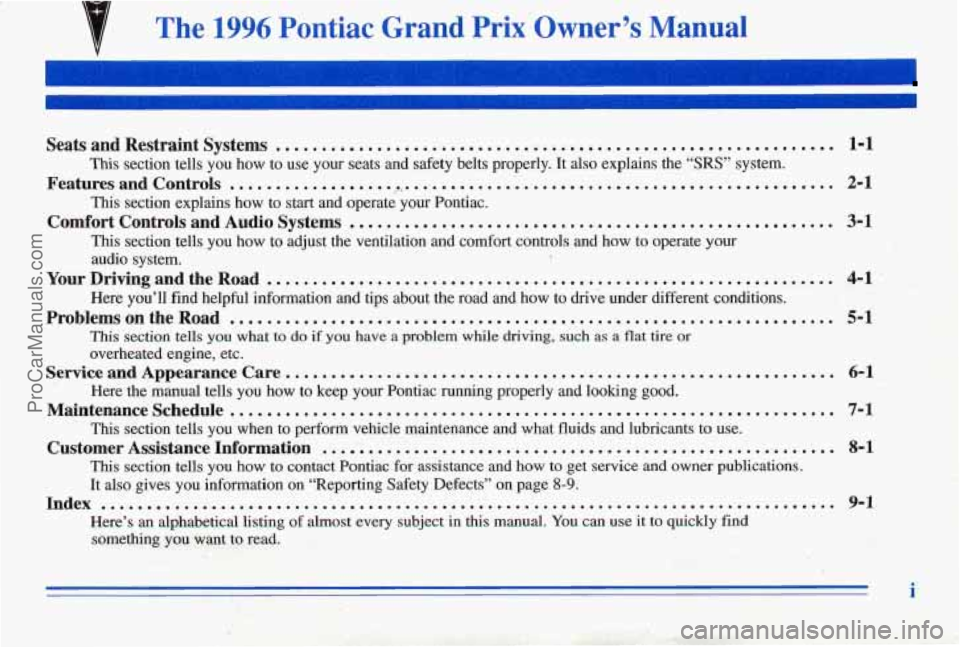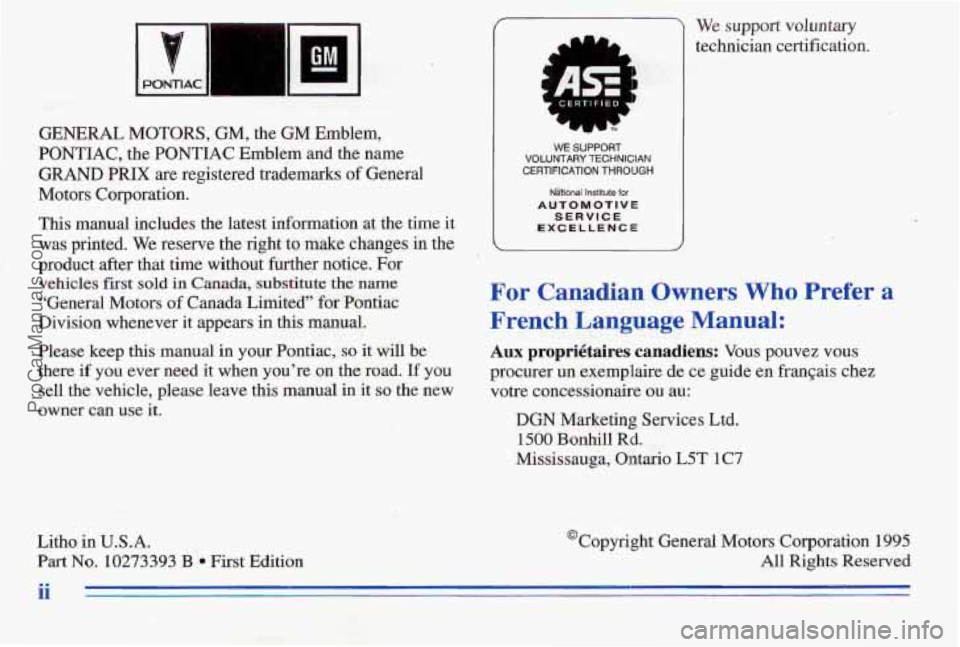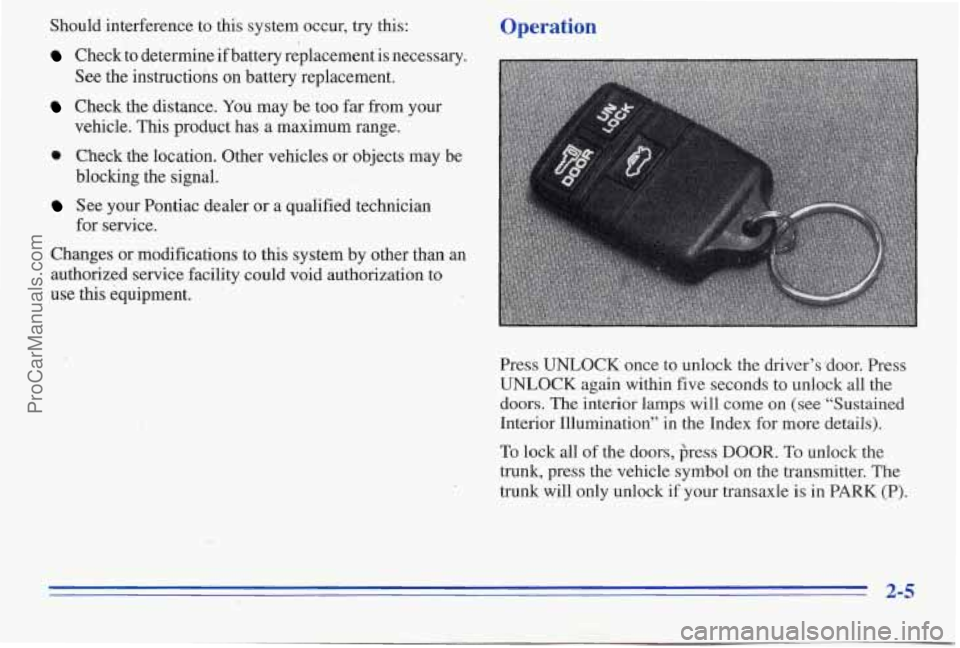1996 PONTIAC PONTIAC service
[x] Cancel search: servicePage 2 of 370

{ The 1996 Pontiac Grand Prix Owner’s Manual
SeatsandRestraintSystems ............................................................. 1-1
This section tells you how to use your seats and safety belts prop\
erly. It also explains the “SRS” system.
This section explains how to start and operate your Pontiac.
This section tells you how to adjust the ventilation and comfort co\
ntrols and how to operate your
audio system.
Here you’ll find helpful information and tips about the road\
and how to drive under different conditions.
This section tells you what to do if you have a problem while driving, such as a flat tire or
overheated engine, etc. Here the manual tells you how to keep your Pontiac running pr\
operly and looking good.
This section tells you when to perform vehicle maintenance and what \
fluids and lubricants to use.
This section tells you how to contact Pontiac for assistance and how to get service and owner pubiications.
It also gives you information on “Reporting Safety Defects”\
on page
8-9.
Here’s an alphabetical listing of almost every subject in this manual. You can use it to qbickly find
something you want to read.
Features and Controls ................................................................... 2-1
ComfortControlsandAudioSystems ..................................................... 3-1
YourDrivingandtheRoad .............................................................. 4-1
ProblemsontheRoad .................................................................. 5-1
Service and Appearance Care. ........................................................... 6-1
Maintenanceschedule .................................................................. 7-1
Customer Assistance Information ........................................................ 8-1
Index ........................................................................\
......... 9-1
i
ProCarManuals.com
Page 3 of 370

I
I PONTlAC II GM
‘3 I
GENERAL MOTORS, GM, the GM Emblem,
PONTIAC, the PONTIAC Emblem and the name
GRAND PRIX are registered trademarks of General
Motors Corporation.
This manual includes the latest information
at the .time it
was printed. We reserve the right to make changes in the
product after that time without further notice. For
vehicles fist sold in Canada, substitute the name
“General Motors of Canada Limited” for Pontiac
Division -whenever it
appears in this manual.
Please keep this manual in your Pontiac,
so it will be
there if you ever need it when you’re on the road. If yon
sell the vehicle, please leave this manual in it so the new
owner can use it.
Litho
in U.S.A.
Part No. 10273393 €3 a First Edition
CERTIFIED y
k- .rl
I
-wT
WE SUPPORT VQUNTABY TECHNICIAN
CERTIFICATION THROUGH
~naltnstttute for
SERVICE EXCELLENCE
AUTOMOTIVE
We support voluntary
technician certification.
For Canadian Owners VVho Prefer a
French Language Manual:
Aux propribtaires canadiens: Vous pouvez vous
procurer un exemplaire de ce guide en fransais chez
votre concessionaire
ou au:
DGN Marketing Services Ltd.
1500 Bonhill Rd.
Mississauga, Ontario L5T 1C7
I’ . - ,.
‘Copyright General Motors Corporation 1995
All Rights Reserved
ProCarManuals.com
Page 35 of 370

What will you see after an air bag inflates?
After the air bag inflates, it quickly deflates. This occurs
so quickly that some people may not even realize the air
bag inflated.
Some components of the air bag module in
the steering wheel hub for the driver’s air bag, or the
instrument panel for the right front passenger’s bag, will
be hot for a short time. The part of the bag that comes
into contact with you may be warm, but it will never
be
too hot to touch. There will be some smoke and dust
corning from vents in the deflated air bags.
Air bag
inflation will not prevent the driver from seeing or
from
being able to steer the vehicle, nor will it stop people
from leaving the vehicle.
I-
When an air bag inflates, there is dust in the air.
people with a history of asthma or other
breathing trouble.
To avoid this, everyone in the
vehicle should
get out as soon as it is safe to do so.
If you have breathing problems but can’t get out
of the vehicle after an air bag inflates, then get
fresh
air by opening a window or door.
~ This dust could cause breathing problems for
I
In many crashes severe enough to inflate an air bag,
windshields are broken by vehicle deformation.
Additional windshield breakage may
also occur from the
right front passenger’s air bag.
0 The air bags are designed to inflate only once. After
they inflate,
you’ll need some new parts for your air
bag system.
If you don’t get them, the air bag system
won’t be there to help protect you in another crash.
A new system will include air bag modules and
possibly other parts. The service manual for your
vehicle covers
the need to replace other parts.
ProCarManuals.com
Page 36 of 370

0
0
Your vehicle is equipped with a crash sensing and
diagnostic module, which records information about
the air bag system. The module records information
about the readiness of the system, when the ‘sensors
are activated and driver’s safety belt usage at
deployment. Servicing Your Air Bag-Equipped Pontiac
Air bags affect how your Pontiac should be serviced.
There
are parts of the air bag system in several places
around your vehicle. You don’t want the system to
inflate while someone is working on your vehicle. Your
Pontiac dealer and the Grand Prix Service Manual have
Let only qualified technicians work
on your air
information about servicing your vehicle and the air bag
bag system. Improper service can mean that your
system. To purchase a service manual, see “Service and
air bag system won’t work properly. See your dealer
Owner Publications” in the Index.
for service.
NOTICE:
If you damage the cover for the driver’s or the
right front passenger’s air bag, they may not
work properly.
You may have to replace the air
bag module in the steering wheel or both the air
bag module and the instrument panel
for the
right front passenger’s air bag.
Do not open or
break the air bag covers.
I
For up to 10 seconds after the ignition key is
turned
off and the battery is discomiected, an air
bag can still inflate during improper service. You
can be injured if you are close to an air bag when
it inflates. Avoid wires wrapped with yellow tape
or yellow connectors. They are probably part
of
the air bag system. Be sure to follow proper
service procedures, and make sure the person
performing work for you
is qualified to do so.
The air bag system does not need regular maintenance.
1-29
ProCarManuals.com
Page 39 of 370

‘2
The lap belt ,should be worn as low on the hips as :: ,’ +-
possible. In a crash, this applies force to the strong ;; I
pelvic bones. And you’d be less likely to slide under the
lap belt. If you slid under it, the belt would apply force
at your abdomen. This could cause serious or even fatal
injuries.
The shoulder belt should go over the shoulder
and across the chest. These parts of the body are best
able to take belt restraining forces.
....
_.rr .
The safety belt locks if there’s a sudden stop or a crash.
It’s possible that an automatic belt could keep you from
fully opening a door. That can happen if the door
was
slammed shut very hard. Just close the door all_the way,
then slowly open it. If that doesn’t fix it, then your
Pontiac needs service.
We hope
you’ll always keep your automatic belt
buckled. Hqwever, you may need to unbuckle it in
an
emergency. And you would need to unbuckle it to let
someone get into the center front seat position,
if your
vehicle has one.
1-32 ‘I
ProCarManuals.com
Page 74 of 370

Should interference to this system occur, try this:
Check to determine if battery replacement is necessary.
See the instructions on battery replacement.
vehicle. This product has
a maximum range.
blocking the signal.
for service.
Check the distance. You may be too far from your
m Check the location. Other vehicles or objects may be
See your Pontiac dealer or a qualified technician
Changes or modifications to this system by other than an
authorized service facility could void authorization to
use this equipment.
Operation
Press UNLOCK once to unlock the driver’s:door. Press
UNLOCK
again within five seconds to unlock all the
doors. The interior lamps will come on (see “Sustained
Interior Illumination” in the Index for more details).
To lock all of the doors, cress DOOR. To unlock the
trunk, press the vehicle symbol on
the transmitter. The
trunk will only unlock if your transaxle is in PARK (P).
I‘-
2-5
ProCarManuals.com
Page 78 of 370

When the PASS-Key I1 system senses that someone is
using the wrong key, it shuts down the vehicle’s starter
and fuel systems. For about three minutes, the starter
won’t work and fuel won’t
go to the engine. If someone
tries to start your vehicle again or uses another key
during this time, the vehicle will not start. This
discourages someone from randomly trying different
keys with different resistor pellets in an attempt to make
a match.
The ignition key must be clean and dry before it’s
inserted in the ignition or the engine may not start.
If the
engine does not start and the SECURITY light is on,
the
key may be dirty or wet. Turn the ignition off.
Clean and dry the, key. Wait about three minutes and try
again. The SECURITY light may remain on during this
time.
If the starter still won’t work, and the key appears
to be clean and dry, wait about
three minutes and try
another ignition key. At this time, you may also want to
check the fuse (see “Fuses and Circuit Breakers” in the
Index).
If the starter won’t work with the other key, your
vehicle needs ‘service. If your vehicle does start, the first
ignition key may
be faulty. See your Pontiac dealer or a
locksmith who can service
the PASS-Key 11.
If you accidentally use a key that has a damaged or
missing resistor pellet, the starter won’t work and the
SECURITY light will flash. But you don’t have to wait
three minutes before trying another ignition key.
See your Pontiac dealer
or a locksmith who can service
the PASS-Key
11 to have a new key made.
If you’re ever driving and
the SECURITY light comes
on, you will be able to restart your engine
if you turn
it off. Your PASS-Key 11 system, however, is not
working properly and must
be serviced by your
Pontiac dealer. Your vehicle is not protected by the
PASS-Key
I1 system.
If you lose or damage a PASS-Key
II ignition key,
see your Pontiac dealer or a locksmith who can service
PASS-Key I1 to have a new key made. In an emergency,
call the Pontiac Roadside Assistance Program at
1-800-ROADSIB or 1-800-762-3743.
2-9
ProCarManuals.com
Page 80 of 370

OFF (C): This position lets you turn off the engine but
still tuin the steering wheel. It doesn’t lock the steering
wheel like
LOCK. Use OFF if you must have your
vehcle pushed
or towed.
RUN (D): This position is where the key returns
after you start your vehicle. With the engine
off, you
can use
RUN to display some of your warning and
indicator lights.
: START (E): This position starts your engine.
A warning chime will sound
if you open the driver’s
door when the ignition is in the
OFF, LOCK or ACC
position and the key
is in the ignition.
NOTICE:
If your key seems stuck in LOCK and you can’t
turn it, be sure it
is all the way in. If it is, then
turn the steering wheel left and right while you
turn the key hard. But turn the key only with
your hand. Using
a tool to force it could break
the key or the ignition switch.
If none of this
works, then your vehicle needs service.
Starting Your Engine
Move your shift lever to PARK (P) or NEUTRAL (N).
Your engine won’t start in any other position -- that’s a
safety feature.
To restart when you’re already moving,
use
NEUTRAL (N) only.
NOTICE:
Don’t try to shift to PARK (P) if‘ your Pontiac
is moving.
If you do, you could damage the
transaxle. Shift to PARK
(P) only when your
vehicle is stopped.
1. Without pushing the accelerator pedal, turn your
ignition key
to START. When the engine starts, let
go of the key. The idle speed will go down as your
engine gets warm.
2-11
ProCarManuals.com